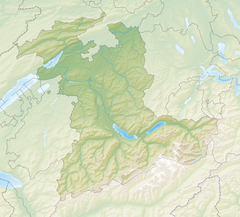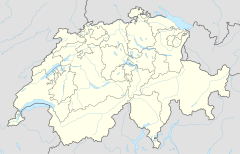
Lauterbrunnen is a village and municipality in the Interlaken-Oberhasli administrative district in the canton of Bern in Switzerland. The municipality comprises the other villages of Wengen, Mürren, Gimmelwald, Stechelberg, and Isenfluh, as well as several other hamlets. The population of the village of Lauterbrunnen is less than that of Wengen, but larger than that of the others.

The canton of Bern, or Berne, is one of the 26 cantons forming the Swiss Confederation. Its capital city, Bern, is also the de facto capital of Switzerland. The bear is the heraldic symbol of the canton, displayed on a red-yellow background.
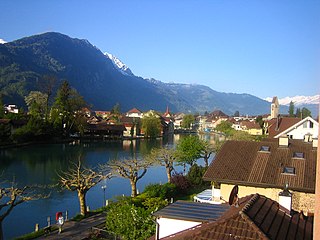
Interlaken is a Swiss town and municipality in the Interlaken-Oberhasli administrative district in the canton of Bern. It is an important and well-known tourist destination in the Bernese Oberland region of the Swiss Alps, and the main transport gateway to the mountains and lakes of that region.

Allmendingen bei Bern is a municipality in the Bern-Mittelland administrative district in the canton of Bern in Switzerland. Besides the village of Allmendingen, the municipality includes the settlement of Märchligen.
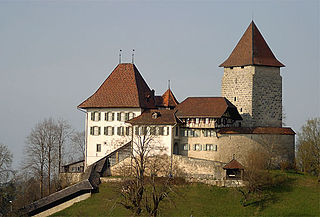
Trachselwald Castle is a castle in the municipality of Trachselwald in the canton of Bern, Switzerland. It is a Swiss heritage site of national significance.

Bolligen is a municipality in the Bern-Mittelland administrative district of the canton of Bern, Switzerland.

The Old City is the medieval city center of Bern, Switzerland. Built on a narrow hill bordered on three sides by the river Aare, its compact layout has remained essentially unchanged since its construction during the twelfth to the fifteenth century. Despite a major fire in 1405, after which much of the city was rebuilt in sandstone, and substantial construction efforts in the eighteenth century, Bern's old city has retained its medieval character.

Wil Castle is a castle from the 13th and 16th century in the municipality of Schlosswil in the Canton of Bern, Switzerland. The castle is a popular destination for locals and is a Heritage Site of National Significance. It was the administrative seat of the Konolfingen District.
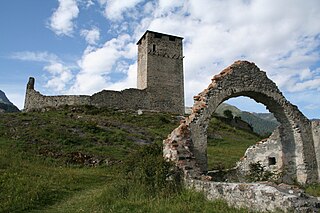
Steinsberg Castle is a ruined castle in the former municipality of Ardez of the Canton of Graubünden in Switzerland. It is a Swiss heritage site of national significance.

Tschanüff Castle is a ruined castle in the former municipality of Ramosch of the Canton of Graubünden in Switzerland. It is a Swiss heritage site of national significance.

Jegenstorf Castle is a castle in the municipality of Jegenstorf of the Canton of Bern in Switzerland. It is a Swiss heritage site of national significance.
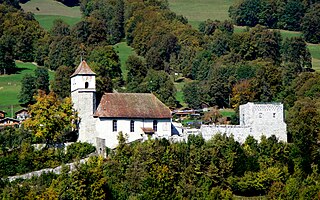
Ringgenberg Castle is a castle in the municipality of Ringgenberg of the Canton of Bern in Switzerland. It is a Swiss heritage site of national significance.

Spiez Castle is a castle in the municipality of Spiez of the Swiss canton of Bern. It is a Swiss heritage site of national significance.

Erguel Castle is a ruined castle in the municipality of Sonvilier in the canton of Bern in Switzerland. It is the best preserved castle ruin in the French-speaking Bernese Jura.

The ruins of Grünenberg Castle, Schnabelburg Castle and Langenstein Castle are a complex of three interconnected castles on a hill above the municipality of Melchnau in the canton of Bern in Switzerland. The three castles formed the center of power of the Barons of Grünenberg in the Oberaargau region during the High Middle Ages.

Mülenen Castle and the attached Letzi Mülenen wall are a ruined medieval fortification in the village of Mülenen and municipality of Reichenbach im Kandertal, in the Swiss canton of Bern. The Letzi Mülenen is a Swiss heritage site of national significance.
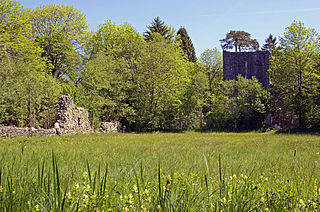
Weissenau Castle is a ruined castle in the municipality of Unterseen of the Canton of Bern in Switzerland. It is a Swiss heritage site of national significance.
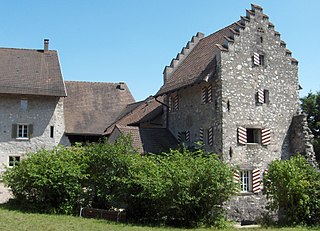
Altenburg Castle is a castle in the village of Altenburg bei Brugg in the municipality of Brugg in the canton of Aargau in Switzerland. The castle and the Altenburg Roman ruins, which are integrated into it, are classified as Swiss heritage site of national significance.

Serviezel Castle is a pair of ruined castles in the municipality of Valsot of the Canton of Graubünden in Switzerland. Very little is known about either castle and they were probably both built in the 12th century for the Lords of Ramosch. Serviezel (Ramosch) is located in the former municipality of Ramosch, while Serviezel (Tschlin) is about 6.1 km (3.8 mi) away in the former municipality of Tschlin.

Castelberg Castle is a ruined castle in the municipality of Ilanz/Glion of the Canton of Graubünden in Switzerland.

